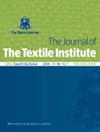Evaluation of the relative significance of fibre diameter and fibre curvature when processing New Zealand Romcross type wool
IF 1.5
4区 工程技术
Q2 MATERIALS SCIENCE, TEXTILES
引用次数: 3
Abstract
Research has shown a technical description of a blend for most woollen carpet applications can be met with objective measurements, namely mean fibre diameter, fibre length after carding, wool bulk, proportion of medullation, base colour and vegetable matter content. The compressional property of wool as reflected in bulk is strongly related to mean fibre diameter and mean fibre curvature. Both these measurements can now be measured simultaneously with recently developed electronic instrumentation. While the processing implications of changes in mean fibre diameter are well understood, the processing implications of changes in objectively measured mean fibre curvature have not been investigated in detail. A total of 360 New Zealand Romcross type fleeces shorn from yearling sheep, with an individual range in mean fibre diameter of 23.2–40.6 μm and an individual range in mean fibre curvature of 34–115°/mm were used. The individual fleeces were sorted to create five, similar-sized, wool-processing lines with the following specifications for mean fibre diameter and mean fibre curvature. Lot 1: low fibre diameter/high fibre curvature (30.2 μm, 72°/mm); Lot 2: high fibre diameter/high fibre curvature (33.5 μm, 70°/mm); Lot 3: medium fibre diameter/medium fibre curvature (32.1 μm, 64°/mm); Lot 4: low fibre diameter/low fibre curvature (31.1 μm, 58°/mm); and Lot 5: high fibre diameter/low fibre curvature (34.5 μm, 51°/mm). Each processing lot was scoured, combed to reduce the proportion of short fibre within each lot and spun into yarn on the semi-worsted system. Mean spindle speed at break (50 fibres in cross-section) and yarn breaking load were greatest for Lot 4 and lowest for Lot 2. Increasing fibre diameter and increasing fibre curvature resulted in less unevenness within the yarn and a decrease in neps. Coarse highly crimped fibre produced the bulkiest yarn while the finer straighter fibre produced the lowest bulk yarn. Potential wearability of knitted garments using yarn spun from each processing lot was assessed using standard knitted squares. Increasing fibre diameter and increasing fibre curvature resulted in greater relaxation shrinkage in length, while decreasing fibre diameter and increasing fibre curvature resulted in increased extensibility in width. Overall resistance to felting shrinkage increased as crimp and diameter increased. There was no difference in pilling between the processing lots. The presented results indicate that increasing fibre curvature in Romcross type sheep as may occur through selection or crossbreeding associated with improving lamb production, will have a beneficial effect on the performance of products made from their wool.新西兰罗姆克罗斯型羊毛加工过程中纤维直径和纤维曲率的相对重要性评价
研究表明,大多数羊毛地毯应用的混纺技术描述可以满足客观测量,即平均纤维直径,梳理后的纤维长度,羊毛体积,棉质比例,基色和植物物质含量。羊毛的整体压缩性能与平均纤维直径和平均纤维曲率密切相关。这两种测量现在可以用最近开发的电子仪器同时测量。虽然平均纤维直径变化的加工含义已经被很好地理解,但客观测量的平均纤维曲率变化的加工含义尚未被详细研究。采用新西兰Romcross型羊毛360根,平均纤维直径为23.2 ~ 40.6 μm,平均纤维曲率为34 ~ 115°/mm。将单个羊毛进行分类,形成5条大小相似的羊毛加工线,其平均纤维直径和平均纤维曲率的规格如下。第一批:低纤维直径/高纤维曲率(30.2 μm, 72°/mm);第2批:高纤维直径/高纤维曲率(33.5 μm, 70°/mm);批次3:中纤维直径/中纤维曲率(32.1 μm, 64°/mm);批次4:低纤维直径/低纤维曲率(31.1 μm, 58°/mm);批次5:高纤维直径/低纤维曲率(34.5 μm, 51°/mm)。每个加工批次都经过洗涤、精梳,以减少批次内短纤维的比例,并在半精纺系统上纺成纱。断纱时的平均纺锤速度(横截面上有50根纤维)和断纱负荷在第4批次最大,在第2批次最低。增加纤维直径和增加纤维曲率可以减少纱线内的不匀,减少棉结。高卷曲的粗纤维产生的纱线体积最大,而较细的直纤维产生的纱线体积最小。利用标准针织方巾对每个加工批次纺出的纱线进行针织服装的潜在耐磨性评估。增大纤维直径和增大纤维曲率导致长度松弛收缩增大,减小纤维直径和增大纤维曲率导致宽度拉伸增大。随着卷曲度和直径的增加,对毡缩的总体抵抗能力增加。加工批次之间起球无差异。上述结果表明,通过选择或杂交提高罗姆克罗斯型羊的纤维弯曲度,将对其羊毛制成的产品的性能产生有益影响,从而提高羔羊产量。
本文章由计算机程序翻译,如有差异,请以英文原文为准。
求助全文
约1分钟内获得全文
求助全文
来源期刊

Journal of the Textile Institute
工程技术-材料科学:纺织
CiteScore
4.20
自引率
5.90%
发文量
149
审稿时长
1.0 months
期刊介绍:
The Journal of The Textile Institute welcomes papers concerning research and innovation, reflecting the professional interests of the Textile Institute in science, engineering, economics, management and design related to the textile industry and the use of fibres in consumer and engineering applications. Papers may encompass anything in the range of textile activities, from fibre production through textile processes and machines, to the design, marketing and use of products. Papers may also report fundamental theoretical or experimental investigations, including materials science topics in nanotechnology and smart materials, practical or commercial industrial studies and may relate to technical, economic, aesthetic, social or historical aspects of textiles and the textile industry.
All published research articles in The Journal of The Textile Institute have undergone rigorous peer review, based on initial editor screening and anonymized refereeing by two expert referees.
 求助内容:
求助内容: 应助结果提醒方式:
应助结果提醒方式:


